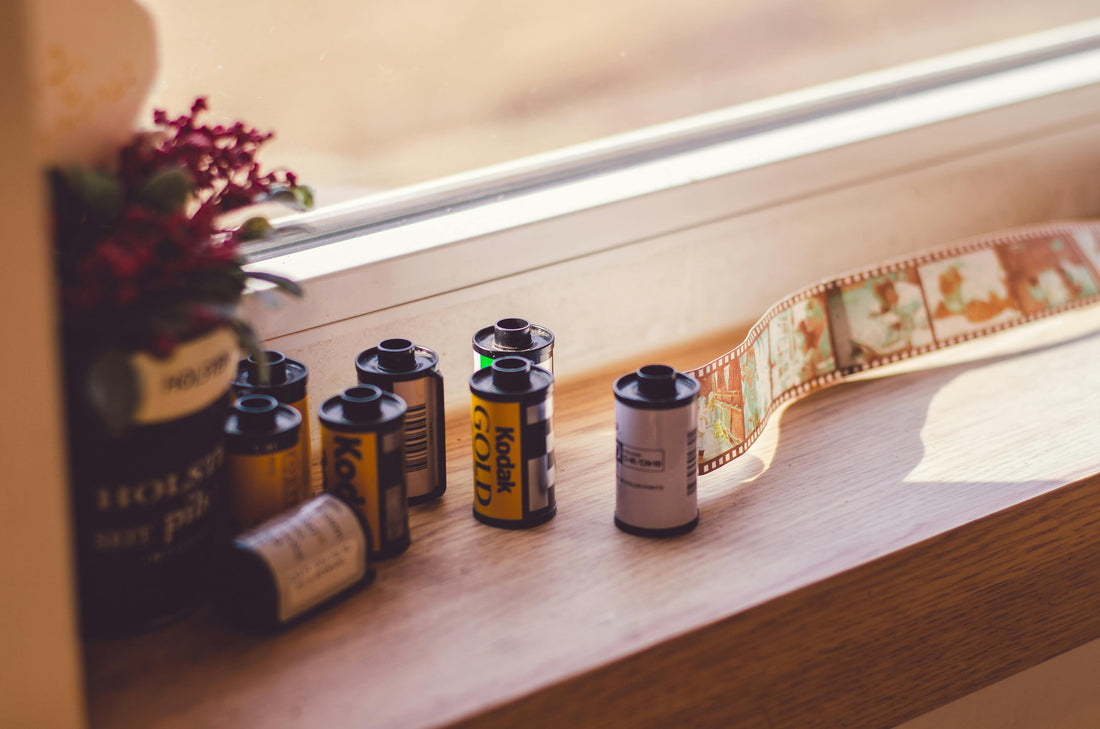
Top 5 Film Stocks to Emulate Digitally
Share
In a digital world, film stocks still rule the aesthetic.
Ask any filmmaker, music video director, wedding shooter, or YouTuber what kind of “look” they want — chances are they’ll name a film stock, not a sensor or codec. There’s something about the color, texture, and emotional tone of real film that keeps creators chasing that analog magic, even when shooting digital.
Luckily, today’s film emulation tools — especially high-quality PowerGrades built for DaVinci Resolve — make it possible to recreate the beauty of specific film stocks without touching celluloid.
In this post, we’ll explore 5 of the most iconic film stocks to emulate, what makes each one special, and how Retrofi Film Emulation brings them to life inside your digital workflow.
1. Kodak Vision3 500T
Best for: Night scenes, moody interiors, neon lighting, low light cinematic looks
Kodak 500T (specifically 5219) is the cinema industry’s go-to tungsten-balanced stock. It’s what you’ll find behind the look of movies like La La Land, Euphoria, and countless music videos and indie films. Known for its high sensitivity (ISO 500), rich shadow retention, and ability to handle bright highlights under mixed lighting, it’s a workhorse of mood and depth.
Key Traits:
-
Strong retention in deep shadows
-
Slight teal cast in midtones
-
Creamy highlight rolloff
-
Subtle halation in practicals
-
Ideal for 24fps motion blur and low-key lighting setups
How to Emulate It Digitally:
-
Shoot at night or in warm practical lighting
-
Use ND filters during the day to preserve shallow depth of field
-
Underexpose slightly (⅓ to ½ stop) for drama
-
Frame tighter — 500T loves intimacy
With Retrofi’s 500T PowerGrade, you get custom halation, glow, teal-orange tonal shifts, and a grain pattern modeled after scanned 35mm. It’s designed to thrive in low light, recreating that cool-yet-warm cinematic atmosphere that defines modern indie visuals.
2. Kodak 250D
Best for: Daylight exteriors, natural skin tones, soft sunny scenes
Kodak 250D (5207) is the daylight-balanced sibling to 500T and a go-to for bright, clean, naturally lit shoots. It’s used in commercials, documentaries, and narrative projects that want a polished film look without sacrificing realism.
Key Traits:
-
Slightly cooler highlights
-
True-to-life skin tones
-
Balanced contrast
-
Excellent highlight retention in outdoor settings
-
Less grainy than 500T, but still organic
How to Emulate It Digitally:
-
Lock white balance at 5600K
-
Expose for skin — 250D loves natural light
-
Use soft diffusion to replicate slight film bloom
-
Perfect for golden hour if paired with slight warmth in post
Retrofi’s 250D emulation adds a gentle glow, natural saturation, and soft grain modeled after 35mm daylight film. It’s especially strong for portraits, travel films, and lifestyle content where you want clean results that still feel analog.
3. Kodak Portra 400
Best for: Portraits, nostalgic tones, soft ambient light, family/romance scenes
Portra 400 isn’t a motion picture stock — it’s still photography film — but it’s one of the most emulated looks in the world of video. Known for its pastel tones, low contrast, and soft rendering of skin, it evokes memory, softness, and emotional intimacy.
Key Traits:
-
Pastel-toned color palette
-
Subtle pink and orange skin bias
-
Low contrast curve
-
Gentle halation in backlit environments
-
A nostalgic, emotional aesthetic
How to Emulate It Digitally:
-
Shoot in ambient light or soft shade
-
Slight overexposure helps capture Portra’s signature tones
-
Frame looser — Portra lends itself to stillness and reflection
-
Avoid harsh practicals — it thrives in soft, natural light
Retrofi’s Portra 400 PowerGrade softens highlights, cools the shadows, and wraps skin tones with peach and pink warmth. It’s the look for story-driven content: weddings, music videos, interviews, or emotional doc-style visuals.
4. AGFA Ultra 50
Best for: Fashion, bold contrast, music videos, stylized commercial work
AGFA Ultra 50 was known for its bold saturation and razor-sharp look — it was discontinued years ago, but it lives on in the world of emulation. While most film stocks lean soft and nostalgic, AGFA is for those who want vibrance, punch, and attitude.
Key Traits:
-
High saturation — especially reds and blues
-
Sharp grain, especially on expired rolls
-
Strong contrast
-
Harder skin tones — more edgy than flattering
-
Great for editorial, bold color styling, and stylized music videos
How to Emulate It Digitally:
-
Push contrast and vibrancy
-
Shoot bold wardrobe and color schemes
-
Use harder key lights with specular highlights
-
Consider expired AGFA looks for added chaos
Retrofi’s AGFA Ultra emulation is ideal for those chasing a pop-art aesthetic. Think grainy fashion campaign, early-2000s alt energy, or high-styled digital mixed with analog chaos. The grain is punchier, the halation is more aggressive, and the curve is stronger than any of the Kodak options.
5. Expired 16mm / 35mm Film
Best for: Mood pieces, dream sequences, chaotic edits, experimental visual storytelling
Not a specific stock — but an entire aesthetic. Expired film introduces unpredictability: color shifts, increased grain, uneven contrast, strange blooming, and lower dynamic range. It’s gritty. It’s grungy. And when controlled properly, it’s magic.
Key Traits:
-
Crushed shadows and clipped highlights
-
Muted or distorted color rendering
-
Heavy grain
-
Intense halation and bloom
-
A “destroyed beauty” feel — perfect for punk, retro, or dreamlike visuals
How to Emulate It Digitally:
-
Underexpose or overexpose selectively
-
Let shadows fall — don’t try to protect them
-
Embrace motion blur and shaky framing
-
Push colors in post (Retrofi makes it easy)
Retrofi’s Expired Film PowerGrades recreate the chaos without needing actual expired rolls. Whether you’re using the Expired 35mm or the more aggressive Expired 16mm, these grades dial up the grain, crush the blacks, and add powerful halation effects. Great for edit-heavy videos, artistic short films, or just breaking away from polished commercial work.
Bonus: The Teal & Orange Look (Inspired by Push-Processed Reversal Stocks)
While not a “film stock” in the traditional sense, the teal & orange look has roots in reversal film pushed for contrast — and it’s become a staple of modern color grading, especially in trailers, music videos, and action content.
Retrofi’s Teal & Orange pack includes 3 PowerGrades modeled on 16mm, 35mm, and expired film behavior, all while leaning into deep blues and sun-kissed skin tones. The vibe is cinematic, dramatic, and intense.
How to Choose the Right Film Stock for Your Project
If you're wondering which stock (or Retrofi look) to use, here’s a cheat sheet:
| Project Type | Best Stock / Emulation |
|---|---|
| Music Video (gritty) | Kodak 500T or Expired 16mm |
| Portrait Film | Portra 400 |
| Fashion Editorial | AGFA Ultra |
| Daylight Travel Doc | Kodak 250D |
| Experimental Short | Expired 35mm + Film Burn Pack |
| Commercial Trailer | Teal & Orange |
Each of these looks is more than a color grade — it’s a mood board in motion. That’s why Retrofi was built to give digital creators the ability to match film stock vibes with real control.
Why Use Retrofi Over a LUT?
Film LUTs are static. They apply a fixed transformation with no flexibility. But real film isn’t static — it shifts depending on exposure, lighting, contrast, and context.
Retrofi is built in DaVinci Resolve using node-based PowerGrades that let you:
-
Adjust grain density
-
Toggle halation or glow
-
Modify saturation, curve response, and rolloff
-
Add film-style bloom without external plugins
-
Work in a non-destructive, fully customizable way
Each emulation is handcrafted with creative grading tools — not just color, but texture, light behavior, and emotion.
Final Thoughts: You Don’t Need to Shoot Film to Look Like Film
Whether you're trying to capture the cinematic depth of Kodak 500T or the nostalgia of Portra 400, you don’t need to shoot on a Bolex or burn through rolls of celluloid. You just need to shoot with intention — and emulate with the right tools.
That’s where Retrofi comes in. Built for digital filmmakers who want their footage to feel analog, Retrofi is the bridge between your camera and the film stocks you love.
Explore the Full Retrofi Collection:
🎞️ Shop All PowerGrades
🔥 Try the Original Pack — Includes 500T, 250D, Portra, AGFA
🎛️ Add Style with Film Burn Transitions + SFX
